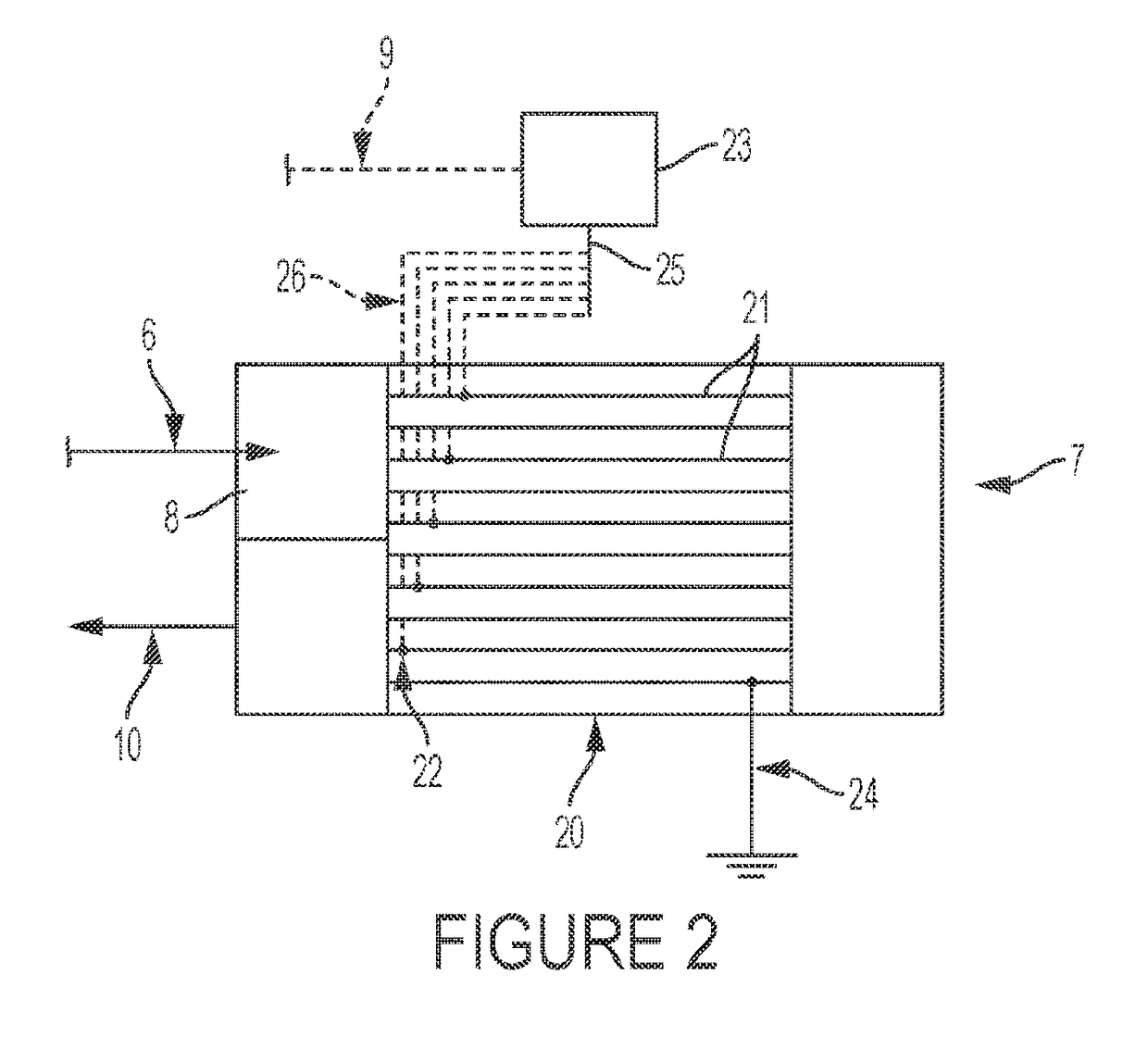Dehydrohalogenation reactor and process
a technology of dehydrohalogenation reactor and process, which is applied in the field of dehydrohalogenation reactor, can solve the problems of high rate of coke or carbon formation, loss of efficiency, and complexity of the system, and achieve the effects of high reliability, high reaction efficiency, and more economical and reliable process
- Summary
- Abstract
- Description
- Claims
- Application Information
AI Technical Summary
Benefits of technology
Problems solved by technology
Method used
Image
Examples
example 1
[0036]In this example, an insulated 1″×0.065″ Inconel 625 tube reactor with a 7-point thermocouple of ⅛″ OD inserted inside of the tube was used. The distance between two neighboring temperature probe points is 4″. The reactor served as the pressure containment vessel, the heating element, and the heat transfer surface. A Flex Kraft Rectifier with maximum output of 5 V and 140 A was used to provide DC (Direct Current) power to the Inconel 625 reactor. Once the hot spot temperature of reactor reached its set point, the flow of 244bb feed was started. During reaction, the reactor effluent was periodically sampled for its compositions.
[0037]Table 1 lists its average reactivity under various conditions. An activity higher than that in conventional (externally heated) reactor was observed in this impedance heater reactor. For example, close to 30% 244bb conversion was achieved at temperatures lower than 450° C. In addition, as shown in Table 1, the selectivity to 1234yf was ≥98.5%.
TABLE ...
example 2
[0038]The same reactor and set-up as described in Example 1 were used in Example 2. Speed runs were conducted by doubling the feed rate. In one experiment, the feed rate was doubled but the DC input power supply was kept at the same (2.57 V / 118.2 A). As shown in Table 2, the doubled feed rate resulted in significant decrease of both hot-spot temperature (from ˜468 to ˜453° C.) and 244bb conversion (from ˜39 to ˜11%). Nevertheless, with input power increasing, both hot-spot temperature and 244bb conversion increased. As shown in Table 2, at 2.76 V / 126.2 A, the hot-spot temperature and 244bb conversion increased to ˜483° C. and ˜40%, respectively. In summary, for the doubled feed rate, comparable 244bb conversion was achieved by increasing electrical input power by about 15%.
TABLE 2 *PeriodDC powerFlow244bbof time,Voltage,Current,Temp. ° C.P,rate,conv.,hVATbottomT1T2T3T4T5Ttoppsigg / h% 897-7.57118.285.6356.4447.7467.7—408.5309.469.945.839.210371015-2.57118.247.7259.4397.1453.2—414.0324...
example 3
[0039]The same reactor and set-up as described in Example 1 were used in Example 3. The effect of HCl / HF treatments was investigated. The HCl / HF treatments were carried by passing HCl (or HF) / N2 mixed flow through the reactor maintained at high temperatures (see Table 3 for conditions). As shown in Table 3, slightly higher 244bb conversion was observed after HCl / HF treatments while 1234yf selectivity remained almost unchanged. Note that selectivity changeover from 1234yf to 1233xf occurred after similar HF treatment in conventional reactor.
TABLE 3 *PeriodFeed 244bb ofTemp. ° C.P,rate,conv.,Selectivity#, %time, hTreatmentTbottomT1T2T3T4T5Ttoppsigg / h%1234yfothers1127-No87.0358.2451.0473.4403.9306.068.945.228.399.40.611651169-In 50%356.7450.5472.5459.4404.5312.869.844.930.299.30.71189HCl / N2flow for 16hat 500° C.1193-In 5%357.2451.1473.4463.6410.2310.770.044.033.999.40.61363HF / N2flow for 16h at 480-490° C.1366-In 5%358.3452.2475.0465.0411.8313.969.543.832.499.50.51575HF / N2flow for 25h a...
PUM
| Property | Measurement | Unit |
|---|---|---|
| temperature | aaaaa | aaaaa |
| temperature | aaaaa | aaaaa |
| temperature | aaaaa | aaaaa |
Abstract
Description
Claims
Application Information
 Login to View More
Login to View More - R&D
- Intellectual Property
- Life Sciences
- Materials
- Tech Scout
- Unparalleled Data Quality
- Higher Quality Content
- 60% Fewer Hallucinations
Browse by: Latest US Patents, China's latest patents, Technical Efficacy Thesaurus, Application Domain, Technology Topic, Popular Technical Reports.
© 2025 PatSnap. All rights reserved.Legal|Privacy policy|Modern Slavery Act Transparency Statement|Sitemap|About US| Contact US: help@patsnap.com



